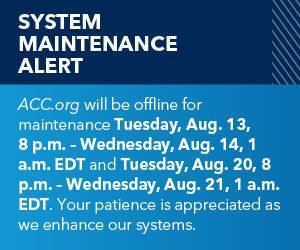Management of Cardiac Sarcoidosis: Key Points
- Authors:
- Sharma R, Kouranos V, Cooper LT, et al.
- Citation:
- Management of Cardiac Sarcoidosis: A Clinical Consensus Statement of the Heart Failure Association, the European Association of Cardiovascular Imaging, the ESC Working Group on Myocardial & Pericardial Diseases, and the European Heart Rhythm Association of the ESC. Eur Heart J 2024;45:2697-2726.
The following are key points to remember from a clinical consensus statement on the management of cardiac sarcoidosis (CS) from the Heart Failure Association, the European Association of Cardiovascular Imaging, the European Society of Cardiology (ESC) Working Group on Myocardial & Pericardial Diseases, and the European Heart Rhythm Association of the ESC:
- Differences in genetic backgrounds and ethnicity influence the prevalence of cardiac sarcoidosis (CS) in the United States. The highest prevalence is seen among Black American women. Average age at presentation is 50–55 years.
- Any cardiac symptom (palpitations, syncope, presyncope, and chest pain) in a patient with known systemic sarcoidosis should trigger the performance of CS evaluation, with CMR as the gold standard tool.
- While evidence about the role of serum biomarkers for the screening of CS is limited, high-sensitivity troponin, B-type natriuretic peptide (BNP), and N-terminal pro-BNP are classical cardiac-specific biomarkers used for both screening and risk stratification of CS.
- Advanced atrioventricular block (AVB) has a prevalence of 10–52% among patients with clinically overt CS. In adult patients aged <60 years with unexplained AVB of second or higher degree, CS represents the underlying etiology in up to 34%.
- While positive echocardiographic findings have high specificity (95–98%), the sensitivity of conventional echocardiography is low (25–27%), especially in the early phases of the disease. Speckle tracking echocardiography is promising in the detection of CS.
- Routine use of cardiac magnetic resonance (CMR) in suspected CS is advised due to its high sensitivity and the power of the technique to exclude CS. Typical appearance of late gadolinium enhancement (LGE) includes the involvement of the right ventricular (RV) side of the basal anteroseptum extending into the subepicardium of the left and/or RV anterior walls. Fibrosis tends to be present in the mid-wall or subepicardium of the left ventricle (especially basally), but the LGE pattern is nonspecific, and it can be challenging to distinguish CS from myocarditis or other cardiomyopathies.
- Whole-body and cardiac fluorodeoxyglucose positron emission tomography (FDG-PET) using the radiotracer FDG are advised for the diagnostic workup of patients with suspected CS. PET is also used to evaluate response to therapy, monitor disease, and guide risk stratification, and prognosis.
- Histologically, sarcoidosis is characterized by non-necrotizing epithelioid cell granulomas containing aggregates of CD68 + macrophages and multinucleated giant cells, T-lymphocytes, and typical epithelioid cells. Due to the focal nature of the disease, the sensitivity of endomyocardial biopsy is approximately 25% from unselected RV biopsies. There is a debate on the need for biopsies from lung or lymph nodes to confirm the diagnosis of extracardiac sarcoidosis in patients with highly suggestive clinical history of CS, CMR, or PET imaging in patients who do not have a positive endomyocardial biopsy. A tissue biopsy is a required for diagnosis according to the Heart Rhythm Society (HRS) consensus statement.
- There are three available diagnostic criteria with some differences that result in challenges when attempting to compare CS cohorts across the world: HRS, World Association of Sarcoidosis and Other Granulomatous Disorders, and Japanese Circulation Society.
- The differential diagnosis of CS includes the following: a) different forms of myocarditis (infective, eosinophilic, or giant cell), b) different forms of cardiomyopathic processes, c) rare infections causing granulomatous inflammation, and even d) coronary artery disease.
- Given the complexity and multisystem nature of the disease, the authors strongly believe that a multidisciplinary team approach to the diagnosis and management of CS may be considered as a reference standard, as this can improve diagnostic accuracy and provide patient-centered treatment plans.
- Clinical evaluation and electrocardiogram are advised as the screening strategy for CS in patients with known extracardiac disease despite their low sensitivity and specificity. CMR can detect subclinical disease, but the clinical significance of such detection is uncertain.
- The underlying cause of AVB, as well as atrial and ventricular arrhythmias, is associated with myocardial damage linked to inflammation and/or fibrosis. A combination of antiarrhythmic medications, device implantation when appropriate, and anti-inflammatory medications are usually used for the management of rhythm abnormalities. An implantable cardioverter-defibrillator (ICD) rather than a permanent pacemaker should be implanted in patients with CS who present with an advanced AVB or fulfill another requirement for pacing. An ICD should be implanted in patients with CS presenting with sustained ventricular tachycardia (VT)/ventricular fibrillation and/or left ventricular ejection fraction <35% failing to improve with heart failure (HF) medication. Catheter ablation is probably helpful in patients with CS with recurrent VT despite antiarrhythmic and immunosuppressive therapies.
- Immunosuppressive treatment is associated with a reduction in adverse events and the resolution of myocardial inflammation that can be viewed as disease-modifying. Corticosteroids are considered first-line treatment, while a second-line agent is introduced early to avoid long-term corticosteroid side effects.
- The LGE extent on CMR, RV involvement on CMR and FDG-PET, and FDG uptake on PET are features associated with a worse prognosis and merit careful evaluation in the context of ICD implantation decision-making.
- HF usually develops as a result of extensive myocardial damage. Heart transplantation in patients with CS and advanced HF has similar outcomes compared with patients with alternative underlying diseases.
- While there has been significant progress in the field of CS since the introduction of advanced multimodality imaging, higher-quality evidence to guide clinical practice relating to the diagnosis, screening, and management of CS is warranted.
Clinical Topics: Arrhythmias and Clinical EP, Heart Failure and Cardiomyopathies, Noninvasive Imaging, Implantable Devices, EP Basic Science
Keywords: Atrioventricular Block, Diagnostic Imaging, Immunosuppression, Sarcoidosis
< Back to Listings

